REMEMBERING SHANTHA SUNDRAM

REMEMBERING SHANTHA MARY SUNDRAM
6 April 1926 – 7 February 2017
It all began in 1966 when I traveled from Laos where I had been pioneering since 1962 to attend a Summer School in Malacca. On the way, stopped in Penang and was taken to a gathering of friends in the Peel Avenue home of the Sundrams and was introduced to the host Mrs. Shantha Mary Sundram. At once I noticed that she was a marvelous lady with a radiant face, sharp eyes and a sweet smile. I had heard of the Sundrams even before stepping into their house, that they lived quite a comfortable life, and eminently placed in society. It did not take long before I discovered that the Sundrams had sacrificed their lot and dedicated their lives and made their home a sanctuary for everyone who entered therein.

A young Shantha
Shantha was of an arresting personality, always of radiant spirit, and her qualities of being constantly active with Bahá’í work with no rest was one that distinguished her personality. When she took up a task she would utilize all her thoughts and energy on completing them even if she had to go sleepless for days. I remember in 1966 when I was still new to Penang and as a guest of the Sundram family, Shantha made arrangements with Nita, who had just passed her driving license to be driven around to meet friends and see places. The four daughters Navanita, Padma, Susheel, and Malini would gather around me singing and joking. They were well-brought-up, always polite, sweet-smiling and full of mannerism.
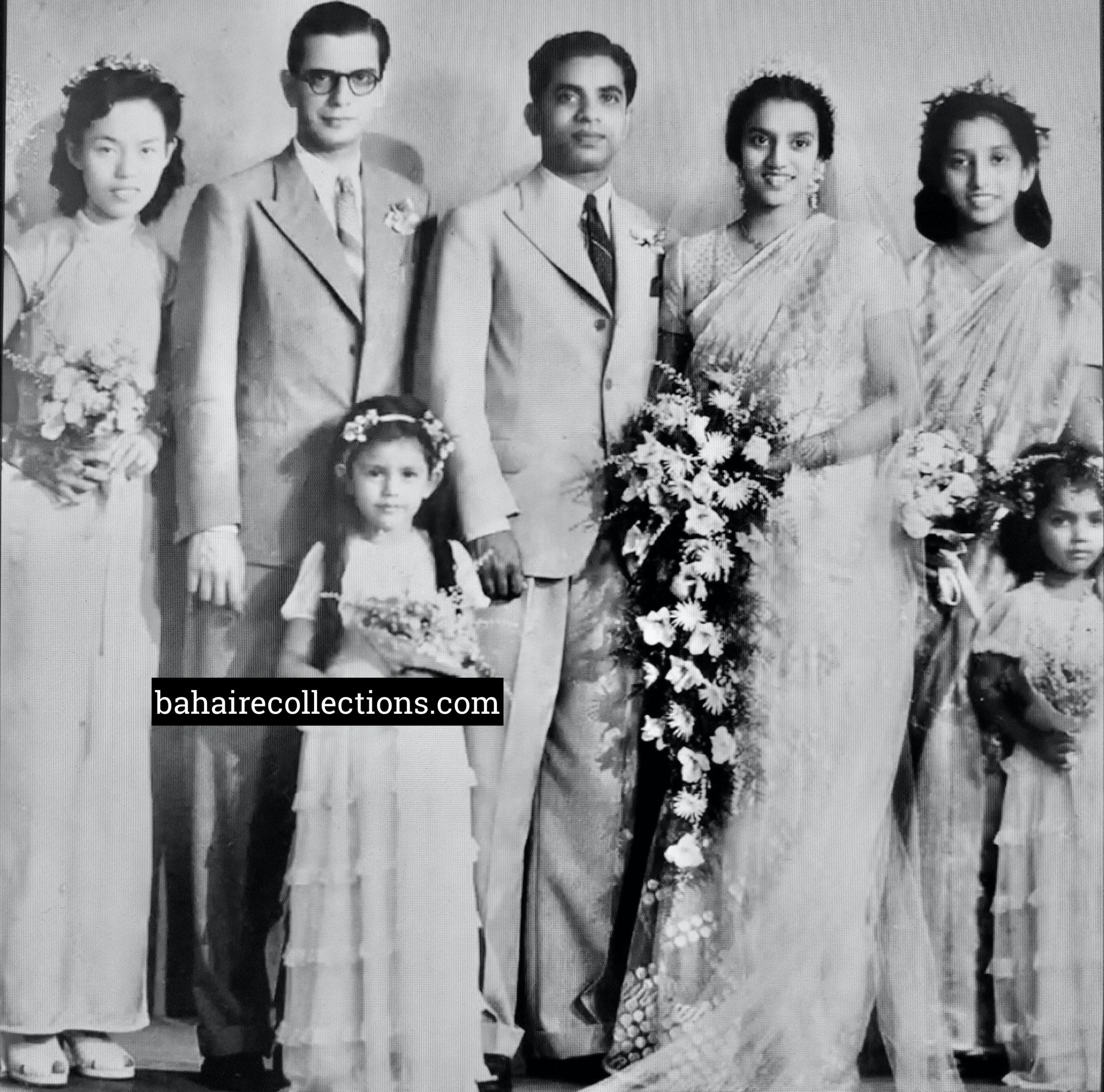
The Sundrams bonded perfectly to serve the Cause in later years.
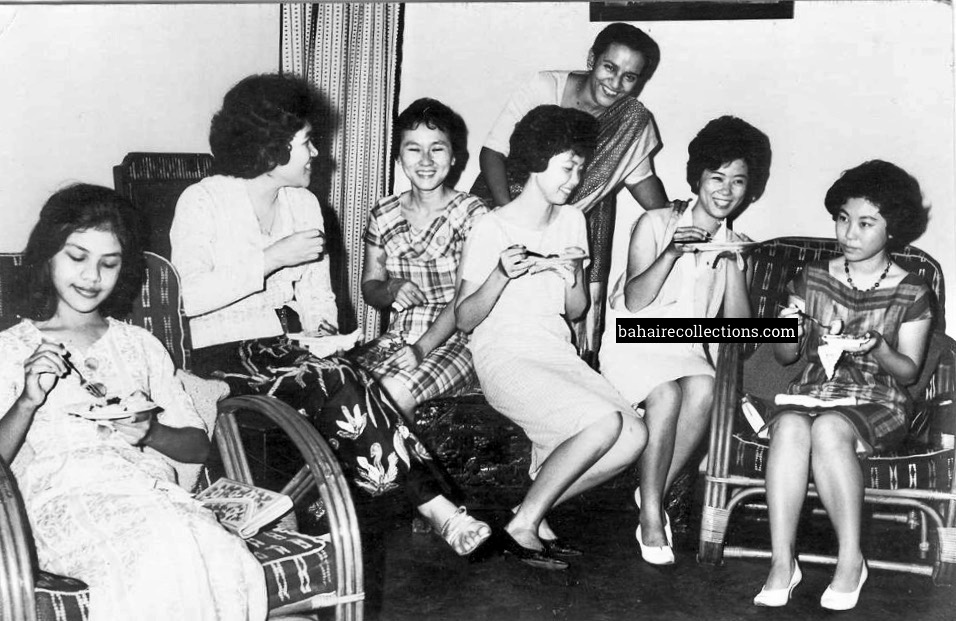
The Sundrams opened their home for the Faith from the time they accepted the Faith.
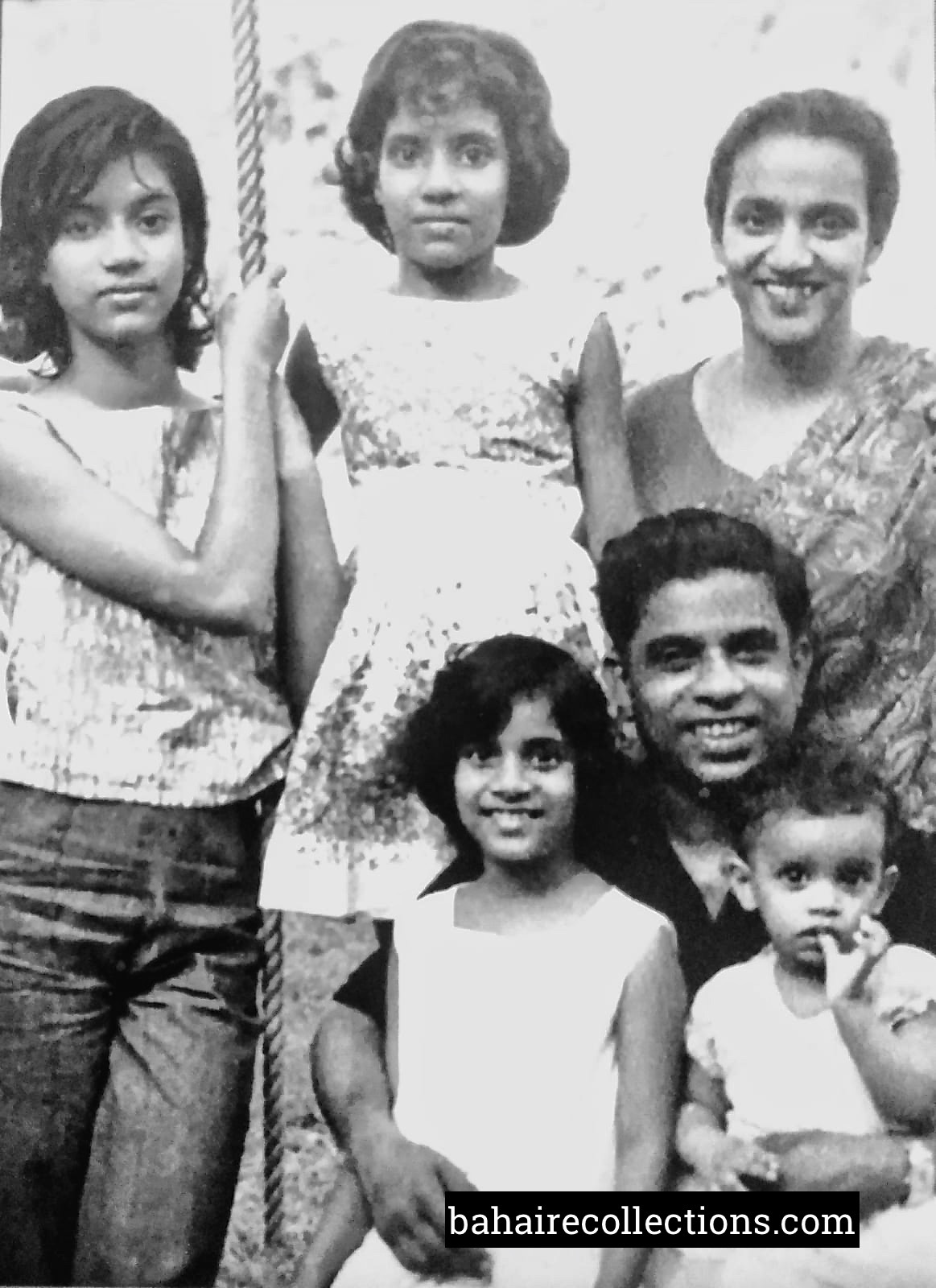
The four daughters were well brought up to serve the Cause.
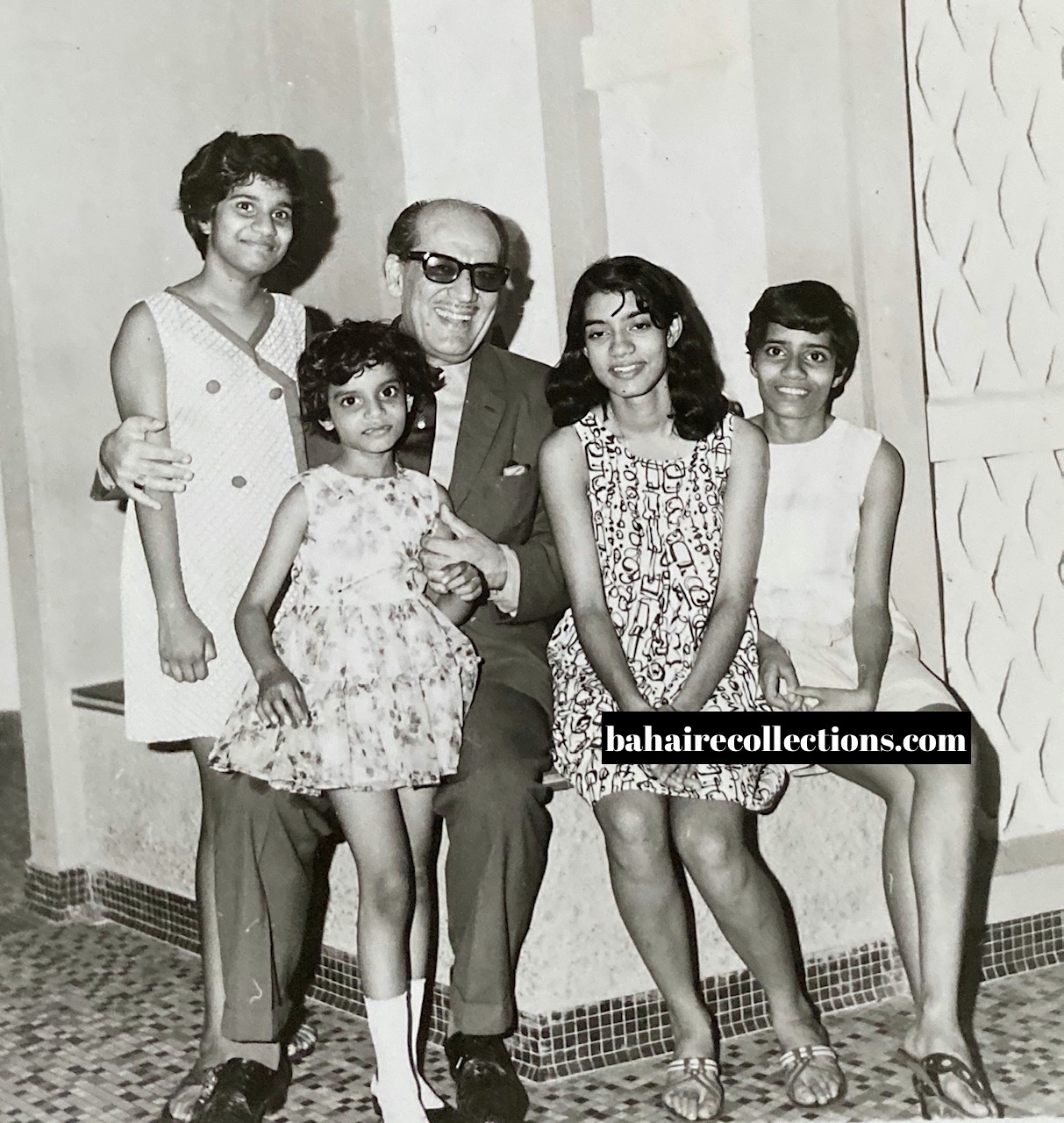
The four daughters with Hand of the Cause of God Abu’l-Qásim Faizi
at the South East Asia Regional Youth Conference 1968.
Shantha became a household name in the Malaysian Bahá’í community when she started in 1965 as the editor of the Malaysian Bahá’í News Magazine, an effective organ of the National Spiritual Assembly of Malaysia. The magazine carried tons of information, news, and deepening materials and linked the believers of her time from all parts of Malaysia and abroad. The Magazine was read by believers and institutions abroad and received high commendations from individual members of the Universal House of Justice, National Spiritual Assemblies, Hands of the Cause of God and pioneers. That was a tiring job carried out with love and enthusiasm.
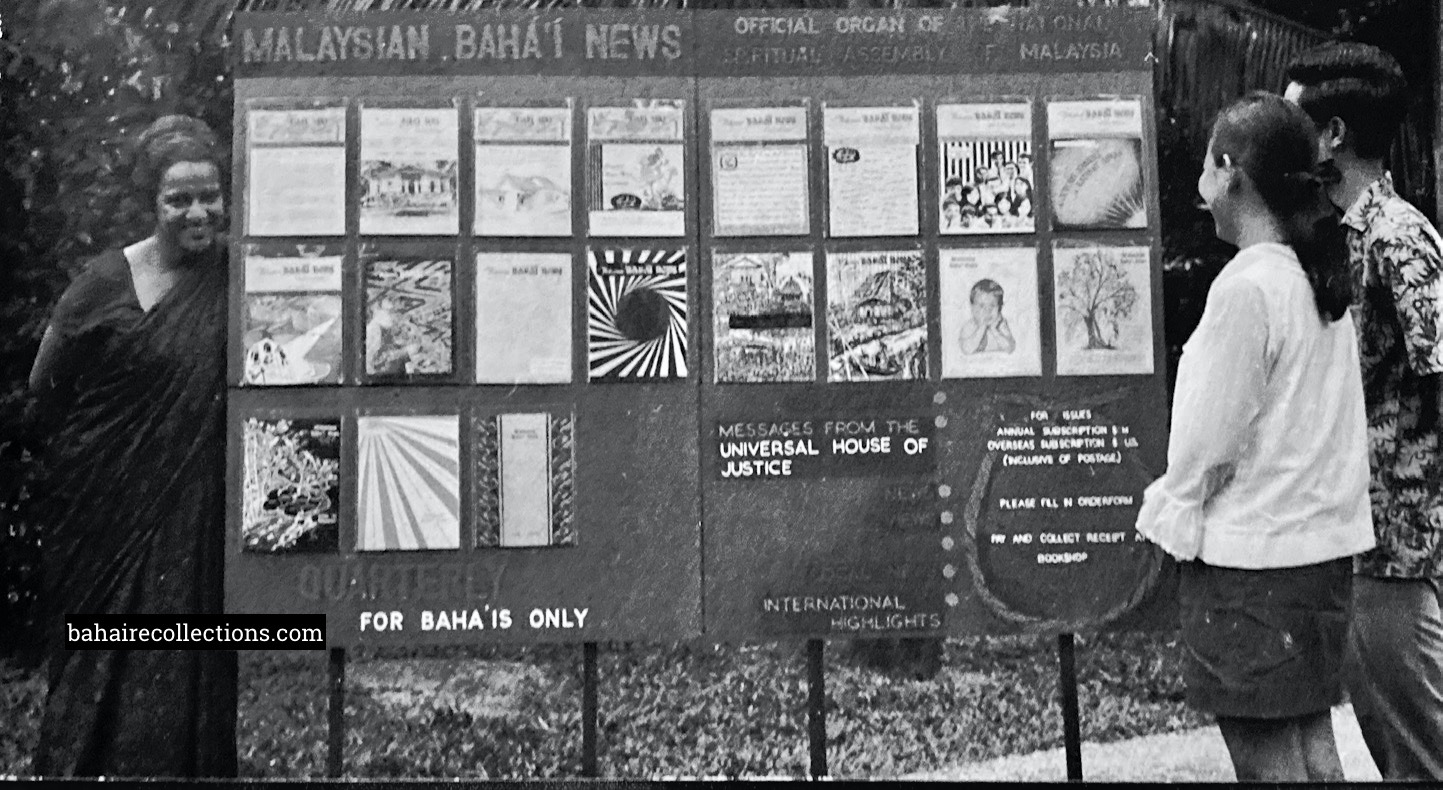
Display of copies of the Malaysian Bahá’í News Magazines at
the Oceanic Conference of the South China Seas in Singapore, 1971.
On several occasions, Shantha spent time sitting beside me and asking questions about the believers and the Bahá’í activities in Iran which I visited from time to time. She also enquired about my pioneering life and activities in Laos. Our discussions would also center on the Tablets of Bahá’u’lláh released in Persian and yet to be translated. It was not easy for me to explain in words the profound spiritual concepts and the hidden meanings especially on the Kitab-i-Iqán but answered to the best of my knowledge and understanding, with my limited knowledge of the English language that I had picked up. Following such casual conversations, I read in the magazine featuring stories about my family and our pioneering life of service. She would be on the lookout for news at every opportunity and from everyone whom she came across. It is still mind-boggling how she was able to accomplish so much with no background training in journalism. Starting with an editorial team she was able to grow and develop and Dr. Sundram providing ideas to improve and promote the magazine all over the globe.
Shantha was full of innovative ideas and creativity. Shantha believed in excellence in all things as her guiding principle in her life, which is evident in all her undertakings. In the mid-1960s Shantha designed, planned and produced most of the Bahá‘í prayer books, posters, and books. Special mention must be made about the white pocket-sized prayer book that the National Spiritual Assembly commissioned Shantha to design and produce in 1974. This essential publication has been reprinted many times over and is found in homes in many parts of the world to this day. Dr. Sundram and Shantha developed Bahá’í songs from the 1960s as they saw in music and songs an effective instrument to keep the spirit of the youth high. She composed some 20 beautiful songs on various Bahá‘í themes, with simple lyrics set to the tunes of popular folk songs. In her book Mystic Connections, she explains in a style of her own how some prominent believers had mysteriously and dramatically come into her life.
Right from the early days, Shantha had spent much of her time as an excellent communicator, keeping in touch with friends through letters, postcards, and phone calls. In later years she communicated through electronic mails. She was a balm to those downtrodden, spending many days of her life moving the hearts of individuals and cheering the hearts in the communities she visited or gatherings she attended. In all these visits she poured forth the needed strength, encouragement and guidance to the Bahá‘í communities. She was always on the lookout of what was happening where. Whenever she met the Bahá‘í women she encouraged them to rise to greater heights of service. Her constant message to the women was, “The kitchen is not your place, you should be out on the field and in service.” She cared for the spiritual well-being of one and all. With her innate generosity of spirit, Shantha identified talents and with her approach of empowerment brought out the best in them to promote the Cause of Bahá‘u‘lláh.

Shantha in the middle among other early heroines of the Faith, Summer School 1960.
Shantha, as I knew, had shouldered various responsibilities. She had served on national committees. In 1969 she was elected into the National Spiritual Assembly, in 1973 appointed Auxiliary Board Member, and served as Counselor from 1988 to 1995 for a wide range of countries with steadfast dedication. During her second term as Counselor, she was also a Trustee of the Continental Fund. She traveled widely and met many communities, giving invaluable advice and guidance, winning the hearts of individuals and institutions. She moved like a colossal figure with a magnetic personality that drew people to her.
Shantha had an acute sense of the needs of the Faith in diverse areas such as in the fields of teaching, Bahá’í scholarship, arts and creativity, community service and the importance of contributing to the Bahá’í funds. Shantha was of the firm conviction that the believers should not only sharpen their administrative or teaching acumen. Several times she mentioned to me the need to immerse in the Holy Writings to be mystically connected to our Creator. The opportune moment was when Jenabe Caldwell an Auxiliary Board Member from Canada and Knight of Bahá’u’lláh for the Aleutian Islands, introduced the Nine Day Institutes in Malaysia in 1972. She herself took a leading role in getting these deepening sessions organized in various parts of the country. She again gave her fullest support to the spiritualization institutes that Jack Davis, an American pioneer to the Philippines, organized in Malaysia in 1989. For years Shantha kept on recalling the impact that such institutes had created in the community.

Nine-Day Spiritualization Institute in Port Dickson, 1972. L-R: Theresa Chee, Betty, Jenabe Caldwell, Koh Ai Leen, and Shantha.
Both Shantha and I had served as members of the National Spiritual Assembly, on the Auxiliary Board and on the Continental Board of Counselors. With such a common background and having worked with her closely, I feel I am qualified to say that in whatever position Shantha served, she had profound respect for the institutions and gave her fullest support to all their undertakings. Her respect and reverence for the Hands of the Cause of God is something that I have witnessed.
I am also aware of the close relationship she had developed with several other Hands of the Cause. She told me that her heart leaped out when coming face to face with several Hands of the Cause at the First Bahá’í World Congress in London in 1963. Some of those Hands had visited Malaysia, while some did not. Yet she was in direct contact with them, who all invariably had admired her resourcefulness. In Ridván 1974, Amatu’l-Bahá Rúhíyyih Khánum attended the National Convention of the Bahá’ís of Myanmar. Shantha participated as a member of the Auxiliary Board from Malaysia, while I attended the convention representing the Continental Board of Counsellors. In the course of the three days of the National Convention, Shantha had a very delightful time of being with Amatu’l-Bahá. Shantha told me that she had always wished for an opportunity of spending more time with Amatu’l-Bahá, having been in her company at the First National Convention held in Malaysia in 1964. She said that at this convention her wish was fulfilled, and she had remained in communication with Amatu’l-Bahá until the latter’s passing.

With Amatu’l-Bahá at the first National Convention of Malaysia in 1964. Lily Chinniah and Koh Ai Leen are standing at the back, and Dr. R.J. Wolff standing at the extreme right.
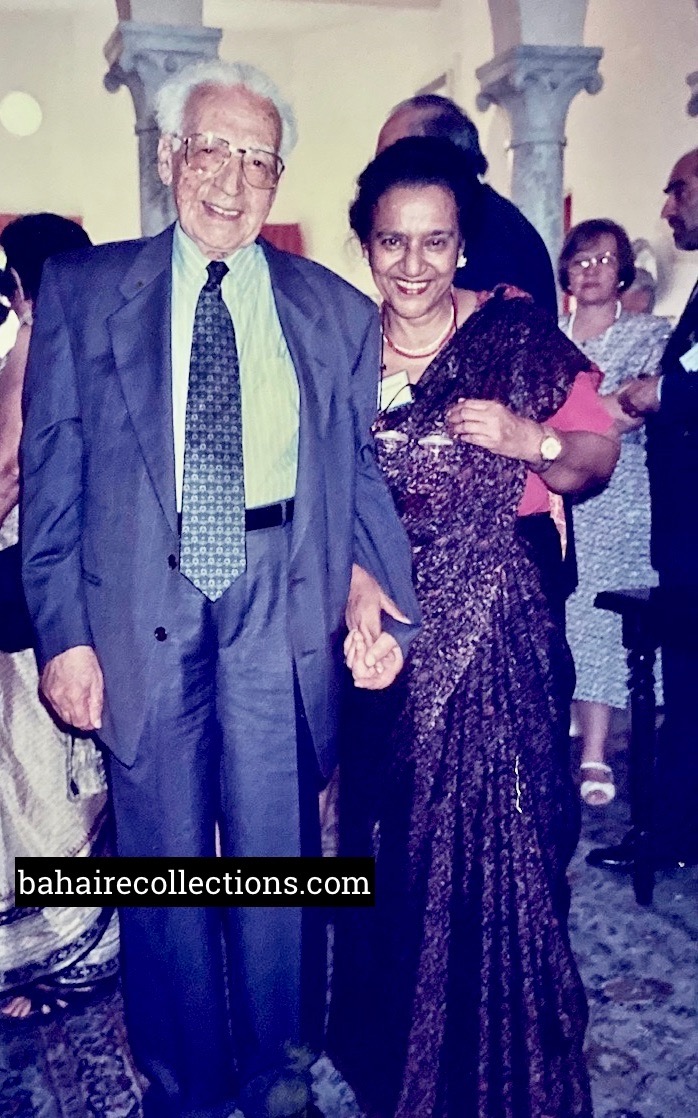
With Hand of the Cause of God Mr.`Alí-Akbar Furútan
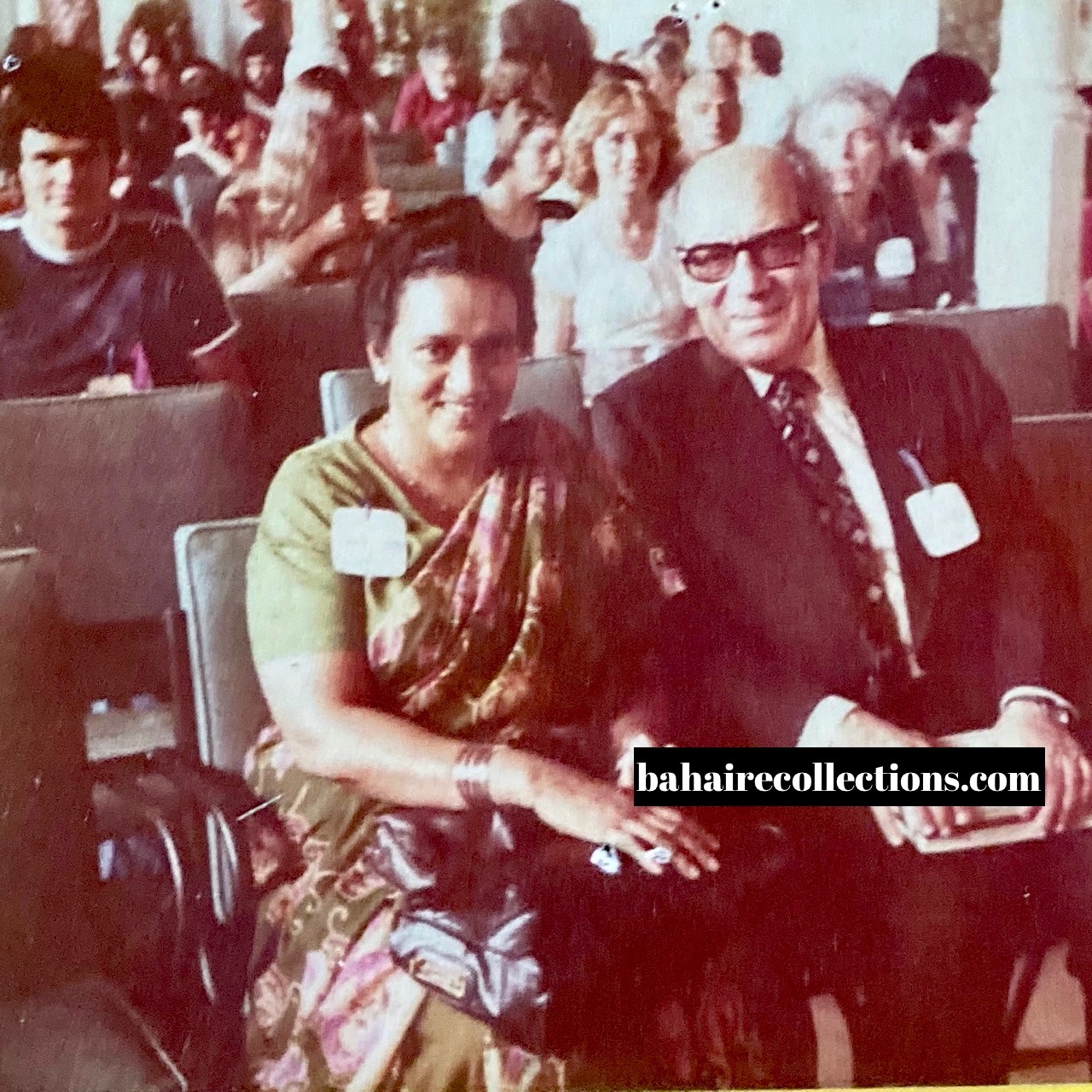
With Hand of the Cause of God Mr. Abu’l-Qásim Faizi

With Hand of the Cause of God Dr. Raḥmatu’lláh Muhájir
Shantha was always on the lookout for serving the Cause and no hindrance that came by was too much trouble for her. In early June 1974 after Shantha and I attended a teaching and consolidation conference in Bangkok. On an evening of a tiring day, a few of us went to a Thai restaurant for light dinner. There Shantha asked some questions regarding the progress of the Faith in Laos, which I explained. She also said that she had never been to Laos and hoped one day she could go over to Laos. Since I was going back to Vientiane on the next evening, I courteously invited her to join me and offered her a complimentary ticket for the overnight bus trip from Bangkok to Vientiane. I was a sales agent for a bus company and was eligible for complimentary tickets. She gladly accepted the invitation there and then. The next evening we boarded the bus to Vientiane. During the four days that she stayed in Vientiane she met the friends at their individual homes and at the National Bahá’í Center. She gave one full day of deepening on the topic of “New approaches and lessons in teaching the Faith.” Her impact on the youth and particularly the women were excellent. They were attracted to her and after each meeting, they stayed back to converse with her. One young lady even followed Shantha and me nearly every day and everywhere we went. One afternoon she even joined us on a small tour of the city. When Shantha was leaving Laos the young lady urged her to come to Laos often. That was her first visit to Laos. I asked if she would rather travel back by air to Bangkok, but she felt fine traveling by the overnight bus. I presented her with a return ticket with the same tour bus to Bangkok. She visited a few more places in Thailand before returning to Malaysia.

Firaydun with Shantha at the South East Asia Regional Conference, Port Dickson, 1976
Perhaps Shantha had a unique role to play. From the early days, I detected the great ability of Shantha in promoting the Faith in the highest echelons of society. In May 1975, representatives of the Bahá’í Communities in Southeast Asia were invited to the Regional Conference of Non-Governmental Organizations organized in Bangkok, by the Office of Public Information of the United Nations in cooperation with the Economic and Social Commission for Asia and the Pacific. The Bahá’í delegation was small composed of four members led by Mrs. Shantha Sundram. Other members were Counsellor Vicente Samaniego from the Philippines, Auxiliary Board member Mrs. Chusiri Faridian from Bangkok and me as a Counsellor from Laos. Shantha was excellent in putting forth the Bahá’í views at the conference that was attended by several countries. At lunch on an earlier day, it happened that we sat together with a prominent delegate from India who was a Member of Legislative Assembly from New Delhi, India and well informed about the Bahá’í Faith. He entered into a profound conversation with Shantha. On the final day, a few delegates were invited to deliver short speeches. When delivering his speech, the Member of Legislative Assembly praised the Bahá’í Teachings and the services and activities of the Bahá’í communities in India. He spoke highly of the Bahá’í Faith and remarked that the final solution to the many problems that had been discussed at that conference lied in the Teachings of the Bahá’í Faith. He said that he was learning valuable lessons from the Bahá’í social Teachings on governance that is based on consultation and invited the delegates of the conference to study them. We knew that Shantha’s conversation with him had prompted him to express his admiration for the Faith. Shantha never missed an opportunity to create an impact on those who are eminently placed in society.

Regional Conference of Non-Governmental Organizations organized in Bangkok.
L-R: Firaydun, Vicente Samaniego and Shantha
In Malaysia, she had moved mainly with a large pool of the believers from the upper and urban brackets. And yet I must admit that I have known of Shantha visiting some rural communities in the interiors and spending nights with them in the absence of even the basic sanitary facilities- all for the love of the Cause. One such trips, Shantha told me was undertaken with Amatu’l-Bahá.
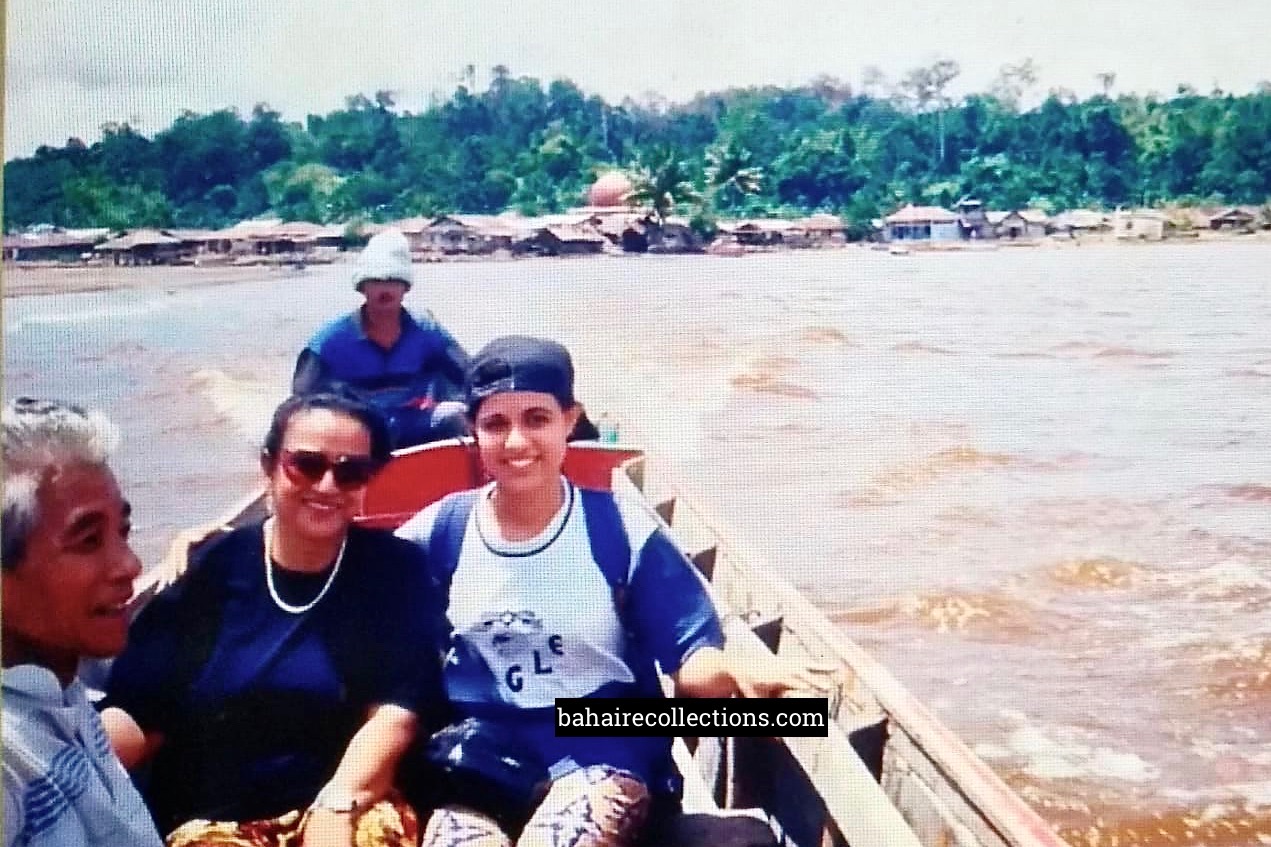
Shantha with her granddaughter Zarrin Tahmasebian crossing the river while visiting rural communities in Mentawai.
Shantha believed that a project that was successful in one part of the world should be repeated or at least experimented in other parts of the world. In the mid-seventies, the Malaysian Bahá’í communities in Penang and Alor Star had developed teaching the Faith through musical firesides. Shantha was a strong supporter of the musical firesides. The youth put the Bahá’í teachings and principles into the songs and performed in public venues in towns. After each performance, the audience gathered around Bahá’ís to listen to direct teaching. In the process many declared. I had attended a few musical firesides and appreciated this method of presentations, its effectiveness, joy, and excitement. From 1975 to 1977 when I lived and served the Faith in Hong Kong, I discussed with Shantha about the possibility of bringing the youth group to Hong Kong and Macao to perform for a week. Although supportive and welcoming, she was not sure about how to finance it. I suggested that if the group could pay for their air tickets they can be the guests of the Hong Kong Bahá’í community for expenses for hotel accommodation, food, local transportation or miscellaneous expenses. It worked out well. In the middle of August 1975, the group of youths led by Shantha arrived in Hong Kong. The choir included, if I remember correctly, Lee Su Hock, Giak Bee, Soh Aik Leng, Ah Chuan, Loh Wan Wan, Lim Li Suan, T. K. Lee, and Shantha’s daughters, Padma and Malini. My wife Giti, our children Sahba aged 7, Samoa aged 2, and Giti’s brother Kamal Maani joined the group. All of us stayed at the Kowloon YMCA hostel located within ten minutes of walking distance from the National Bahá’í Center. But practices for the musical fireside and preparations took place at our meeting room in the YMCA building. The seven days of musical firesides in Hong Kong and Macao attracted many people. Among them were a few Chinese youths who later joined the Faith and took part in the Bahá’í activities. The musical fireside was followed by a 14 day Hong Kong National Teaching Campaign that reinforced the works of the youth and paved the way for intensified teaching activities in Hong Kong. These musical firesides were popular in Malaysia but having them performed in Hong Kong for the first time was significant in promoting the Faith in that very busy and materialistic city where people had little time to pray or think about God.
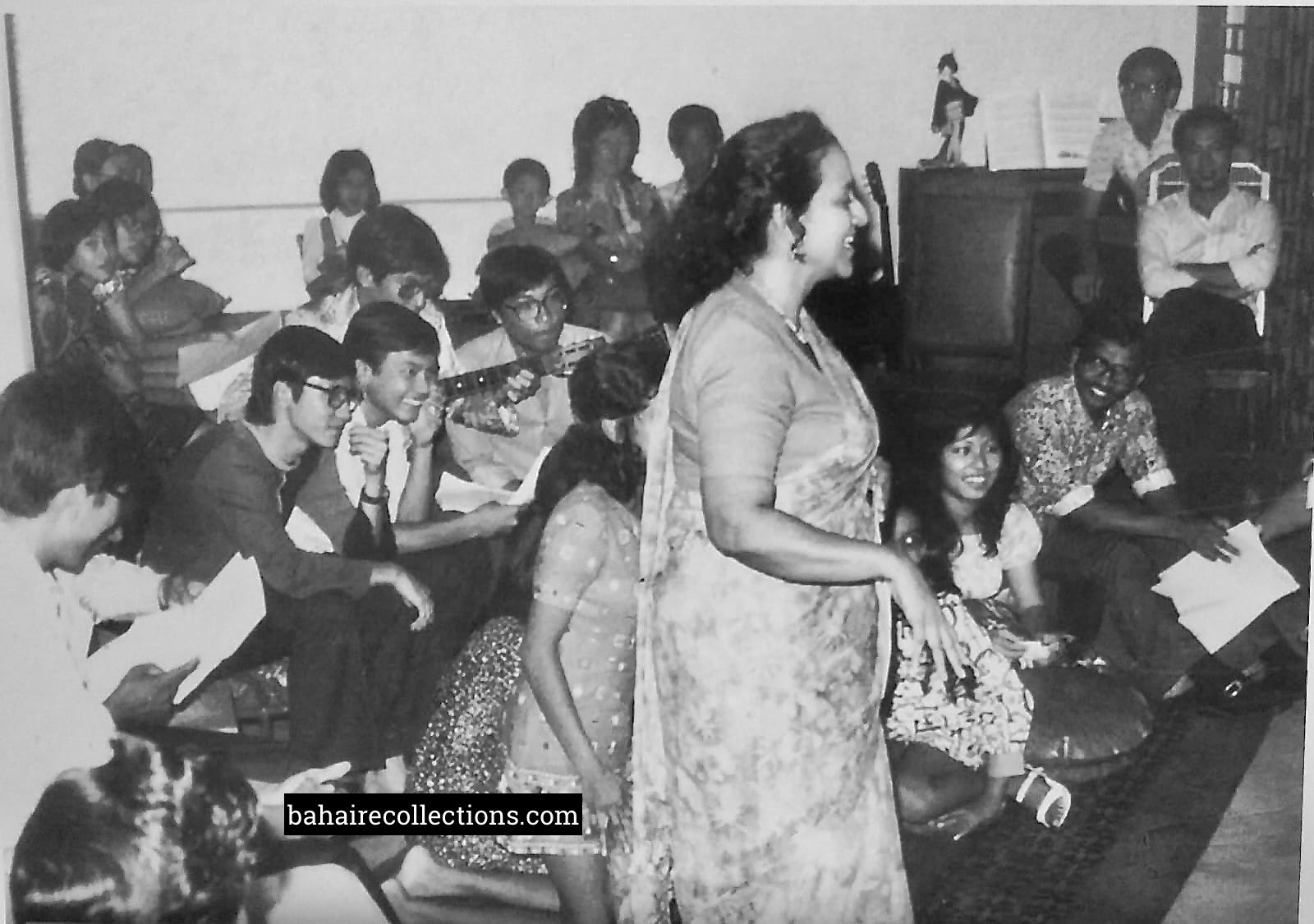
A promoter and motivator of talents among the youths
Shantha had a tremendous influence on building the talents of the youth wherever she went. Her home was a sanctuary for the youths. Shantha identified the talents in the youths and gave them the fullest encouragement to scale beyond their horizon. She employed various approaches in motivating them, from the Writings and from the success stories she had heard from other parts of the world and from interesting anecdotes she had picked up when visiting communities abroad.
Bahá’u’lláh selects His servants to perform specific tasks for His Cause. Having associated with and observed Shantha from the early days, I am more than convinced that Baháʼu’lláh had planned her life. Her first role as Secretary of the first Local Spiritual Assembly of Penang, as editor of the Malaysian Bahá’í magazine, as member in several national committees, as a highly charged speaker at conferences, as member of the National Spiritual Assembly since 1969, as Auxiliary Board member since 1973 and as Continental Board of Counselor in 1988 until she migrated to Australia, she had left indelible traces.

Visiting East Malaysia in December 1968 with fellow members of the National Spiritual Assembly of Malaysia. Shantha is flanked by Tony Fernandez (L) and Inbum Chinniah (R). Standing second from left is Nagaratnam.
Shantha had a burning passion never to miss any Bahá’í gathering, both within Malaysia and abroad. Her first major gathering was the historic Inter- Continental conference held in Singapore in September 1958. I would not be wrong to say that Shantha must be a believer who could have attended most of such international conferences, including the First Bahá’í World Congress held in London in 1963 and the Intercontinental Conference of 1967 in New Delhi. Only under unavoidable situations, she had missed local gatherings within Malaysia.
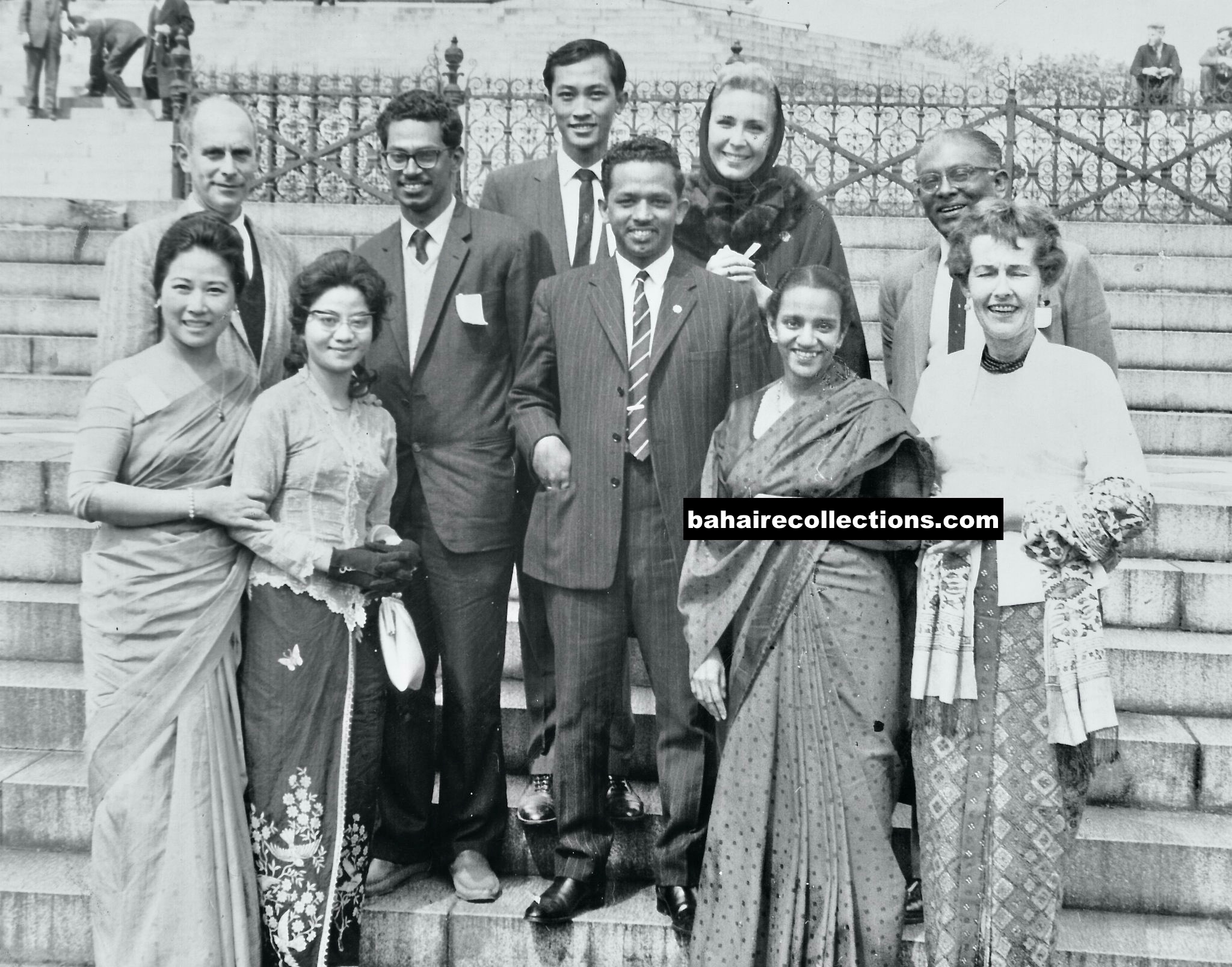
First Bahá’í World Congress in London, 1963. Back row L-R: Dr. R. J. Wolff, S. Bhaskaran, Leong Ho San, Anthony Fernandez, Jeanne Frankel (Spiritual Mother of Shantha) and Appu Raman. Front row L-R: Lily Chinniah, Chiang Kim Lin, Shantha and Elinor Wolff.
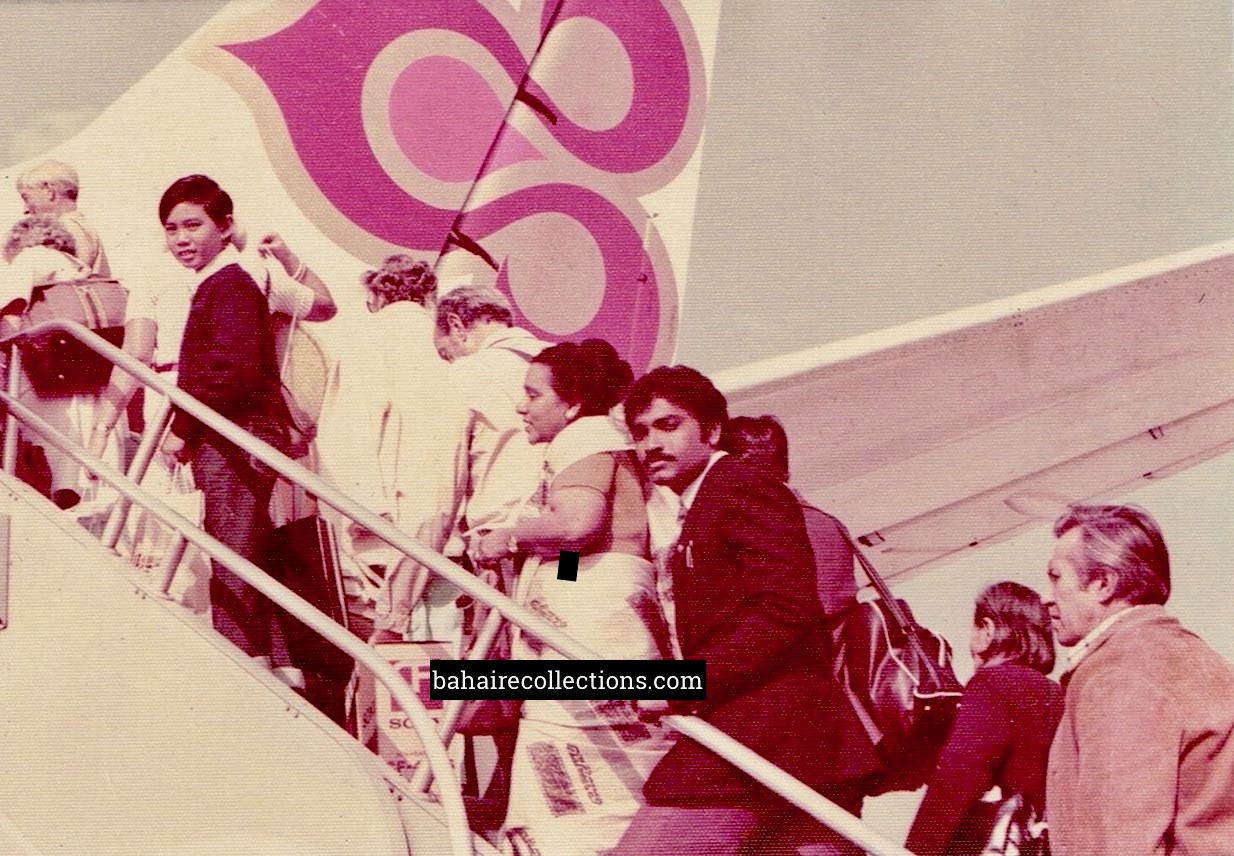
Boarding the chartered Thai Airways in Butterworth town to participate in the Bahá’í International Conference in Hong Kong, 1976. She is followed by Sathia Narayan, one of her spiritual sons.
As I have seen, even while visiting her family overseas, any call to serve the Faith was her priority. In about 1987 when Shantha was visiting her children in Perth, Australia my family and I had migrated to Australia and lived in Carnarvon, a small aboriginal town, located 1,000 km north of Perth. I had to go to Perth for a meeting and to invite a number of believers to our Naw-Rúz celebration to be held that weekend. A day of the proclamation of the Faith was planned in Carnarvon in conjunction with Naw-Rúz celebrations. Upon seeing Shantha I happily invited her to our celebrations in Carnarvon but cautioned that it was a ten-hour drive. To my surprise, Shantha readily accepted the invitation with no second thought. In a couple of days, we were on the road to Carnarvon where Shantha stayed with us for four days. She attended the celebrations, took part in the proclamation activities, met the aboriginal friends in Mengella village and had a lot of fun visiting plantations and picking fruits and vegetables. Eight other friends from Perth joined the celebration and the proclamation as well. Some stayed with us and some stayed with other friends. In the evenings we all gathered together, dined, prayed, sang, chatted, joked and had much fun. One evening we had invited a group of friends to a lamb and Kangaroo barbeque in our backyard. Shantha gave an inspiring talk suitable and apt for our contacts present on that evening. Shantha as I noticed never needed prior notice. One can tell her at the last moment and yet she would turn to be a master storyteller and captor of hearts, with the right choice of words, quoting relevant stories to substantiate her points. Her constant advice to believers was to lace up their boots and stoke up excellence in all they did for the glorious Cause. This was truly remarkable God-given talent in a remarkable lady, Shantha. On the fifth day, Shantha got a lift from one of the visiting cars and returned to Perth. The impact she left behind was phenomenal, especially on the aboriginal women that she had met. Each time I met the aboriginal friends and neighbors, they remembered Shantha and asked about her and wanted to know if she was coming to Carnarvon for another visit.
With more than half a century of association with Shantha, I can state that she did her very best in carrying out her duties, religiously and with absolute sincerity. At times I used to get copies of her letters and reports that she sent to other higher institutions. It was always a pleasure to read those communications. What an analytical mind she had, just like her husband. The choice of her words, her analysis and conclusions and the recommendations she forwarded were inspiring.
Counselor Shantha speaks at the conference with her Auxiliary Board Members and their Assistants in Port Dickson, 1988

Counselor Shantha and Dr. Chellie Sundram cutting a ribbon to open the Chellie Sundram’s Institute for Children Class in Penang, 1991.

Among her close co-workers she had known since 1963- S. Nagaratnam (left) and Ganasa Murthi Ramasamy (right). She had served with both of them on the National Spiritual Assembly of Malaysia, and with Nagaratnam on the Continental Board of Counselors for Asia.

World Religion Day observation, Singapore 1997. L-R: Shantha, Selvam Satanam, Nemat Sabapathy, S. Satanam and William Hui.
Having migrated to Australia, her heart and soul were still glued to the Malaysian Bahá’í community. In many of her conversations with me Shantha had mentioned how much she loved the Malaysian Bahá’í community. She, together with her daughter Susheel made annual visits to Malaysia until three years before her passing. In each of the visits, she met up with her old friends. In each community Shantha visited, she always had a list of names of believers, both serving or had distanced themselves of whom she would enquire. From wherever she was accommodated, Shantha would phone them or pay them a visit with a genuine concern for them. Mr. Manisegaran shares an interesting incident in which he was present. In 1998 Shantha was present as an observer at the National Bahá’í Convention held in Hotel Malaya in Kuala Lumpur. Dato Dr. M. Singaravelu who was Chairman of the National Spiritual Assembly invited her to say a few words. As Shantha walked to the microphone, she broke down and sobbed, quite uncontrollably, looking for appropriate words to express herself. She said to this effect, “You would not know how wonderful a community you Malaysian believers are. And you may not know how much I am already missing this lovable and loving community with which I had grown from 1958. If at all I have one regret in my life, it is not being able to live among you Malaysian believers. One thing for sure, the Malaysian believers and the national institution have received so many praises and accolades from the Supreme Body, the Hands of the Cause of God and visitors, as no other country that I had known. You are indeed a special breed of people who shall always occupy a permanent place in the innermost center of my heart….” As she was sobbing and choking, several believers who had known did not have dry eyes.
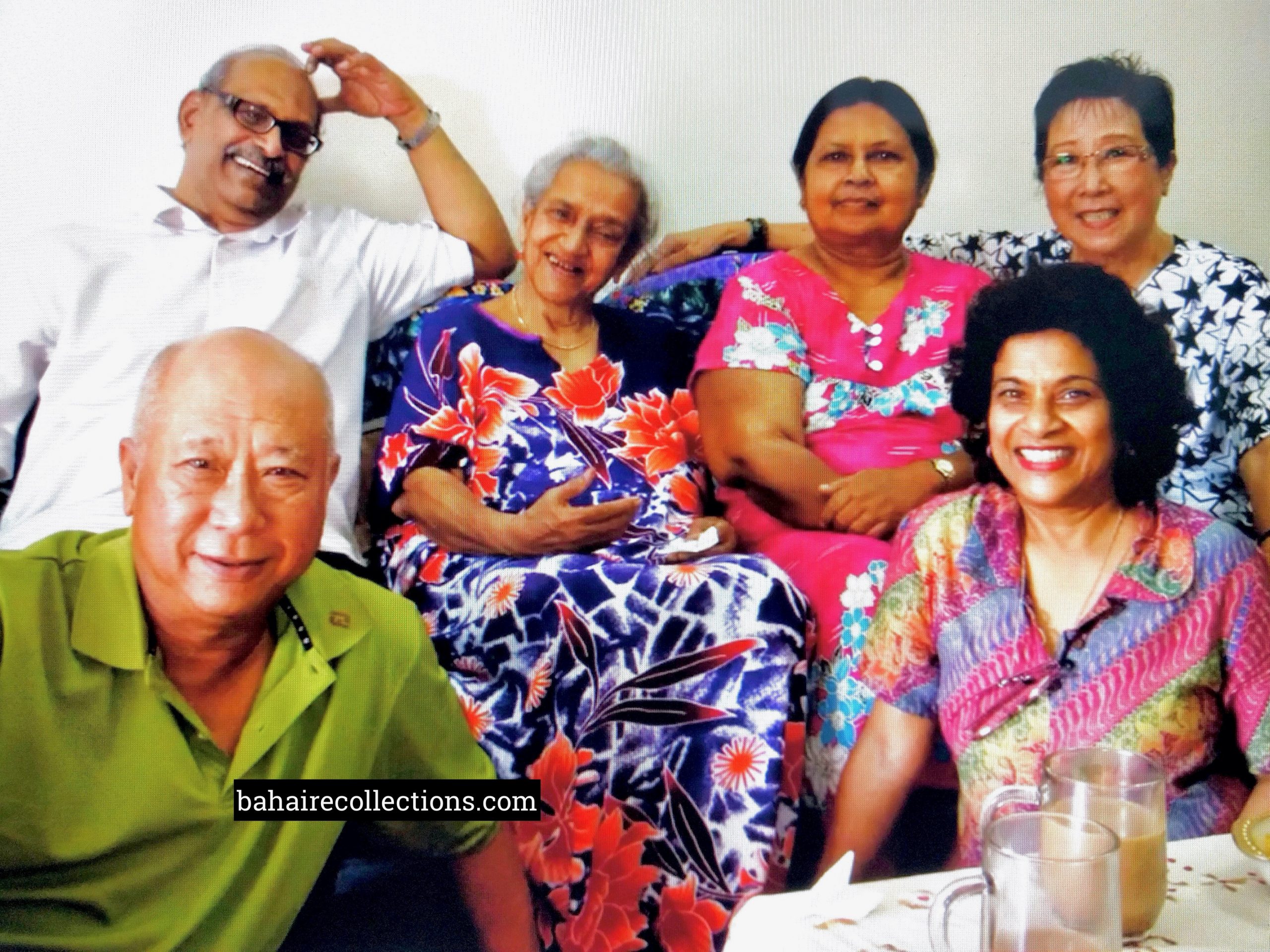
One of her last visits to Malaysia. L-R: S. Bhaskaran, Shantha, Sarojini Bhaskaran, and Lily Chinniah.
In the front row are James Liew (L) and Shusheel Croft (R).
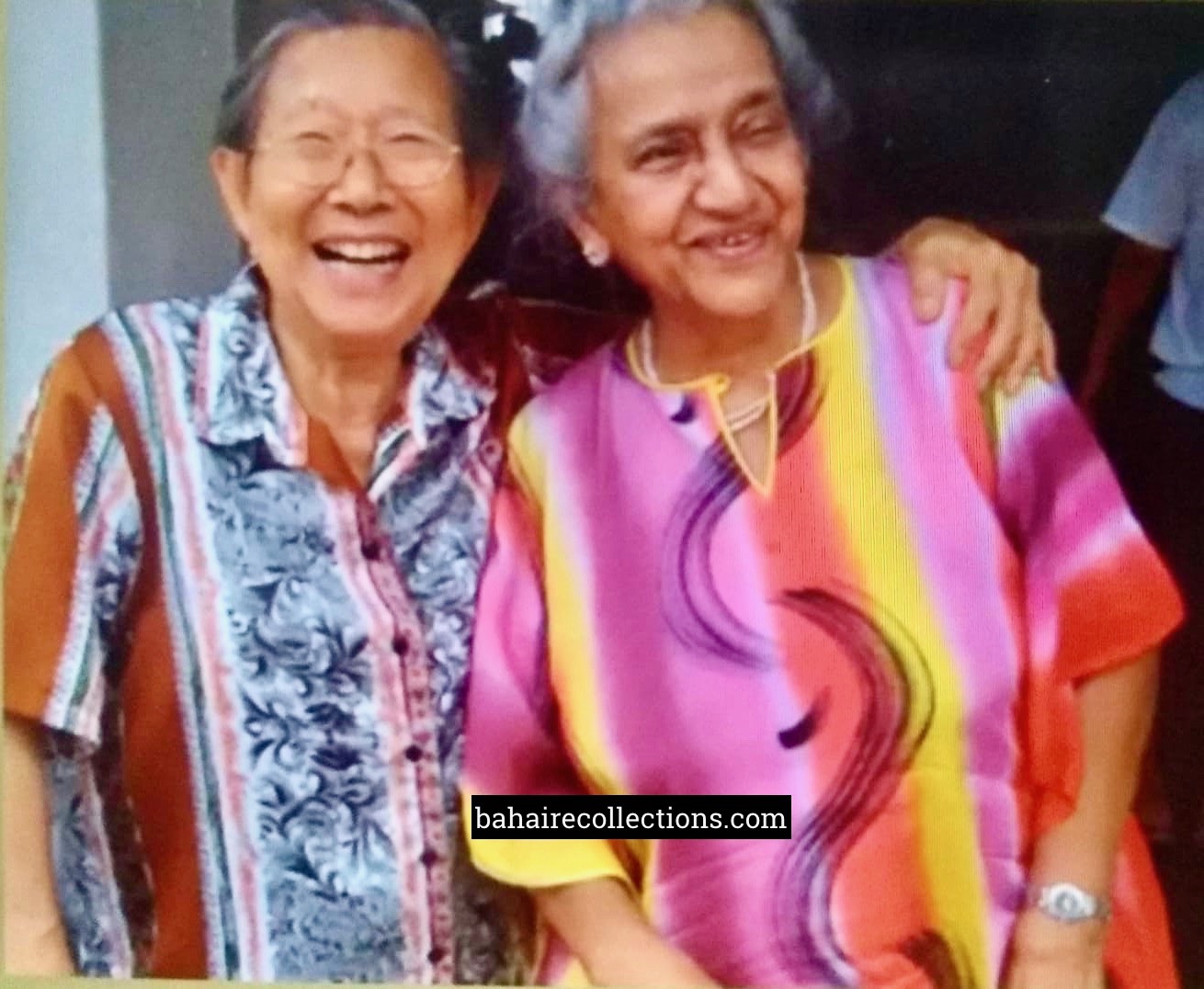
With Theresa Chee, whom Hand of the Cause of God Dr. Muhájir called “Spiritual Mother of the Northern believers.” Shantha and Theresa had known each other since 1958.
Shantha was a very loving mother figure to the Bahá’í community, not only to her family members. When Dr. Sundram suffered a stroke in April 1989, I still remember the loving care with which she enveloped him, and taking him to different places. Dr. Sundram was a painter, artist, and photographer. Soon he recovered and started to paint again, with the support that Shantha gave. Sad to say that he was called to the kingdom on high on February 22, 1993, leaving a void in the Malaysian Bahá’í community and the wider community.
Seldom had I seen both husband and wife serving with unbridled zeal and energy, with the Faith in the center of their lives. The Sundrams are of this rare kind. My friendship and association with the Sundram family have deepened and reinforced in the span of over five decades since 1966, and during this period I also got to know the four angels of the Sundrams – Navanita, Padma, Susheel, and Malini. Undoubtedly, they have inherited from their parents the mighty energies for the service of the Cause of God.
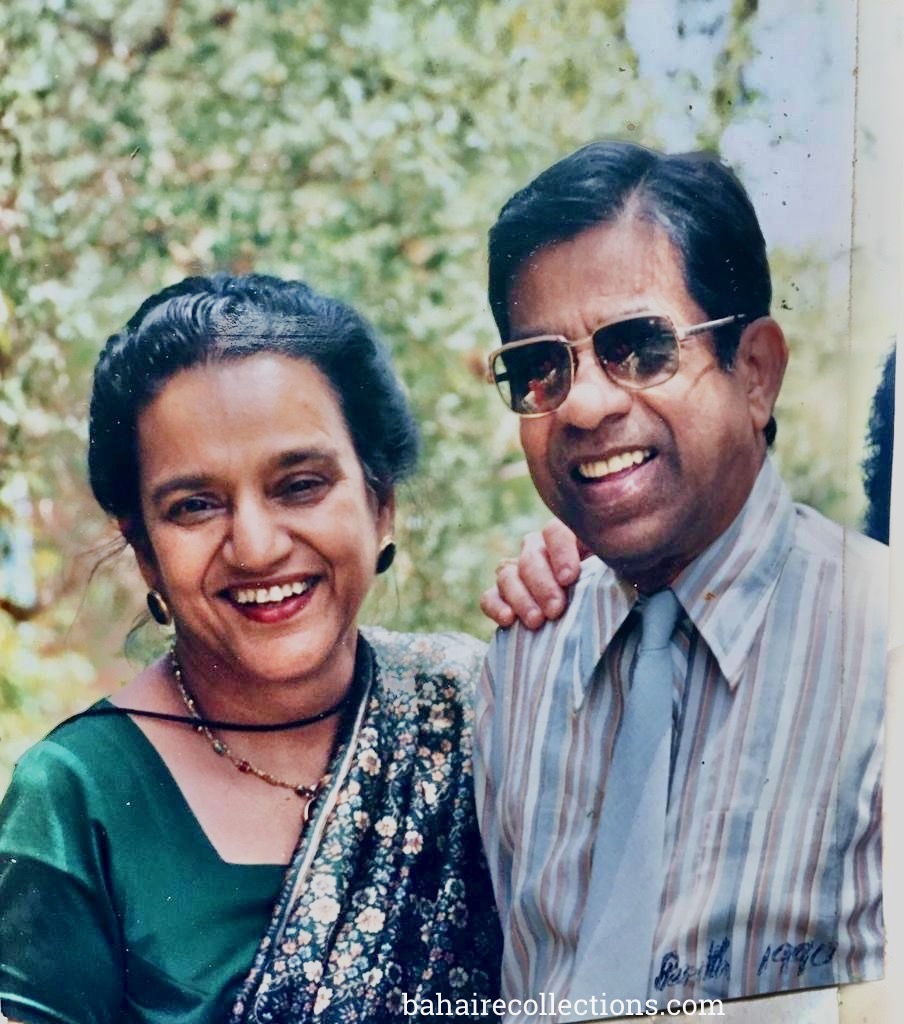
One heart, one soul and one aim – to serve the Blessed Beauty
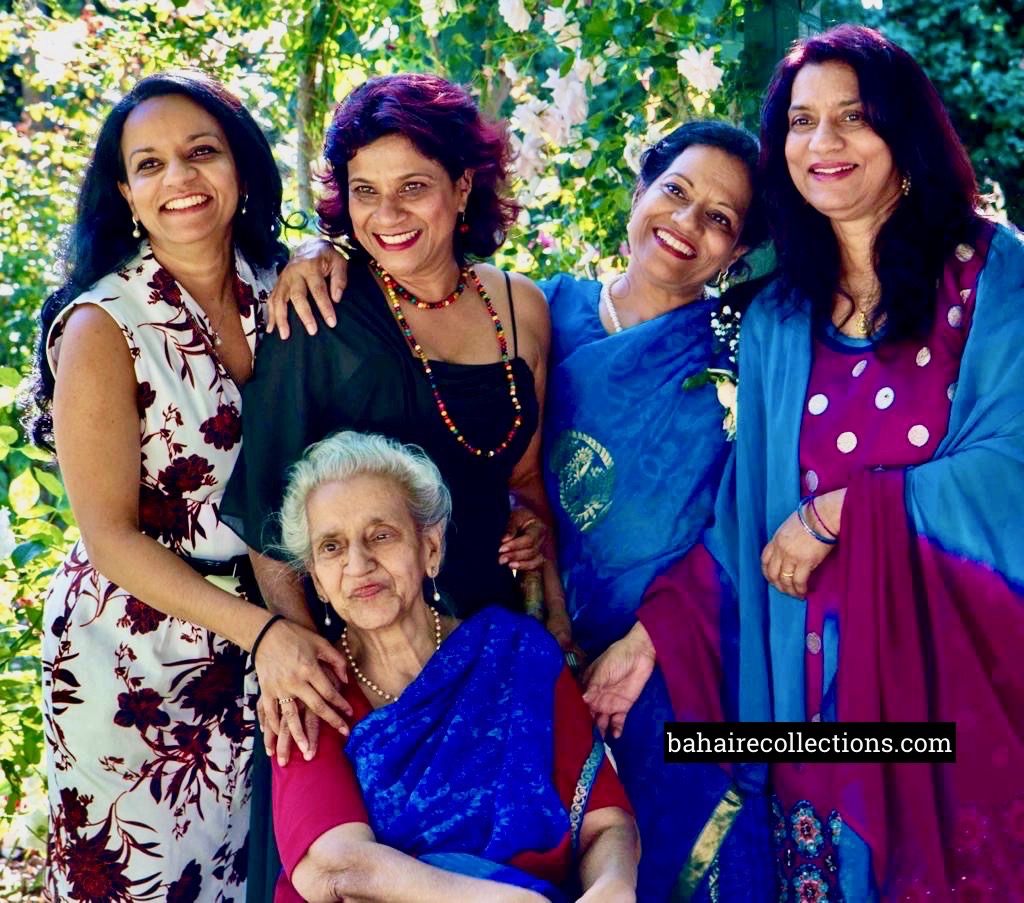
With the four daughters L-R: Malini Parker, Susheel Croft, Padma Wong, and Navanita Sundram.
Despite old age, Shantha kept conversing with an erudition that belied her age. Sadly that was not to last till the end of her life. The last time I saw her was in Perth at Malini’s home by which time she was quite thin and had lost part of her memory. Fortunately, and surprisingly she recognized me immediately and said, “I know this guy”. Naturally, I was happy that she recognized me. From what i knew, she had a photographic memory when she was alert in her earlier days in Malaysia. I was living in China when I learned she had passed away on 7 February 2017. My mind immediately recalled her as a person full of love, wisdom, insight and above all a sincere and devoted servant of the Cause of God. I prayed fervently for the progress of her pure soul and wished her progress in all the eternal realms of God. Then I could only visit her blessed grave, offer humble prayers and beseech her assistance from the realms of the Abhá Kingdom. No Bahá’í can truthfully ignore any thinking on the subject that Shantha had a unique role in the development of the Faith in Malaysia and the region. From the day she accepted the Faith, till her last days she remained like a “Rock of Gibraltar” in the Covenant.
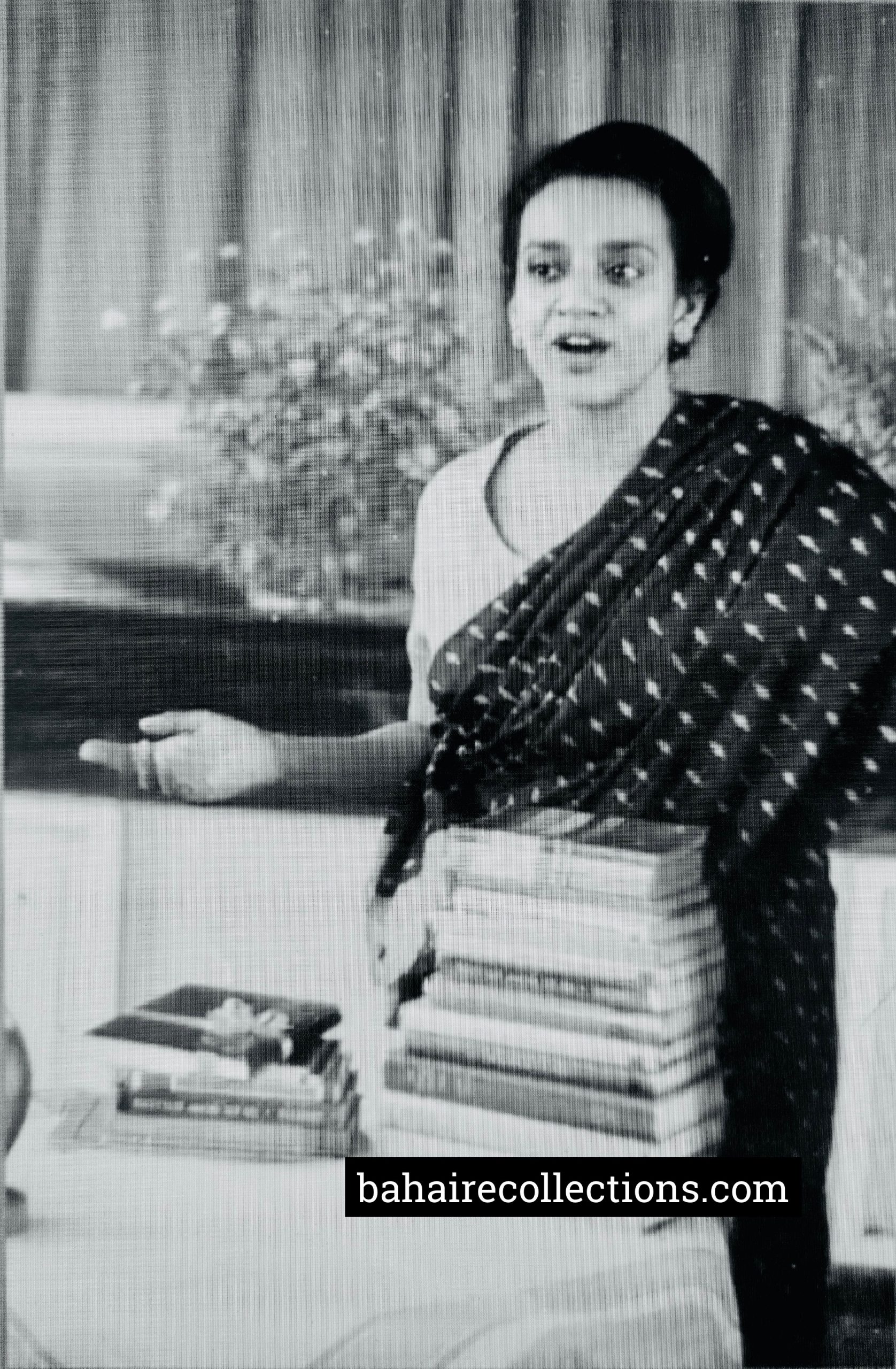
A master story-teller and a great motivator from the early days.
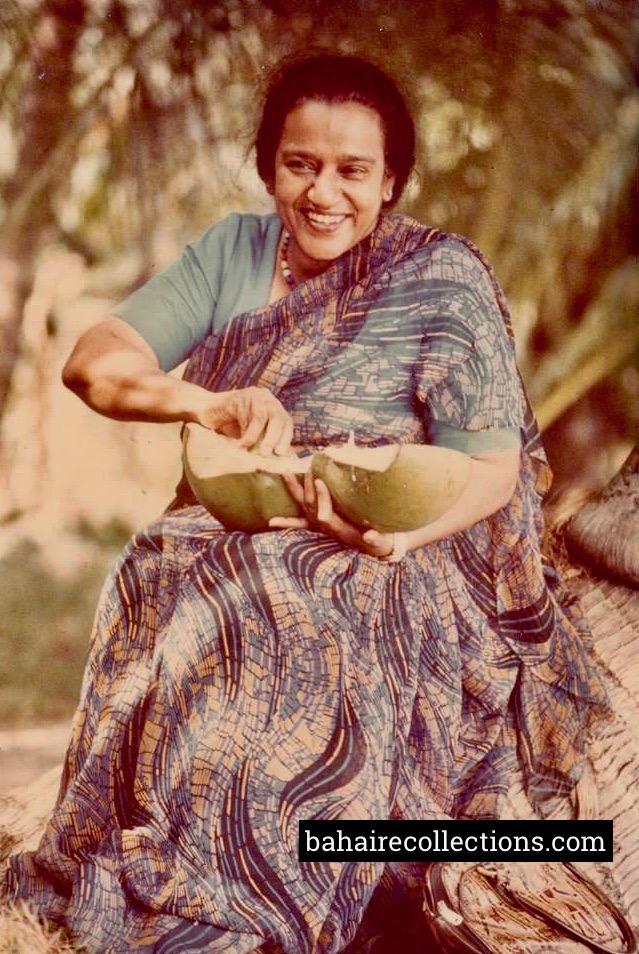
A radiance that was always of Shantha.
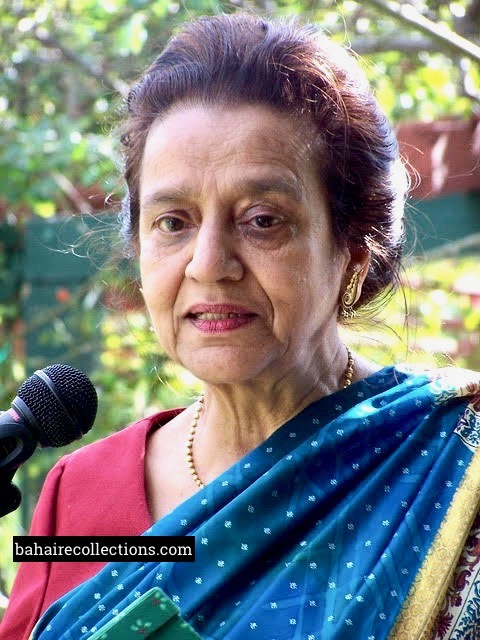
Celebrating her 80th birthday.
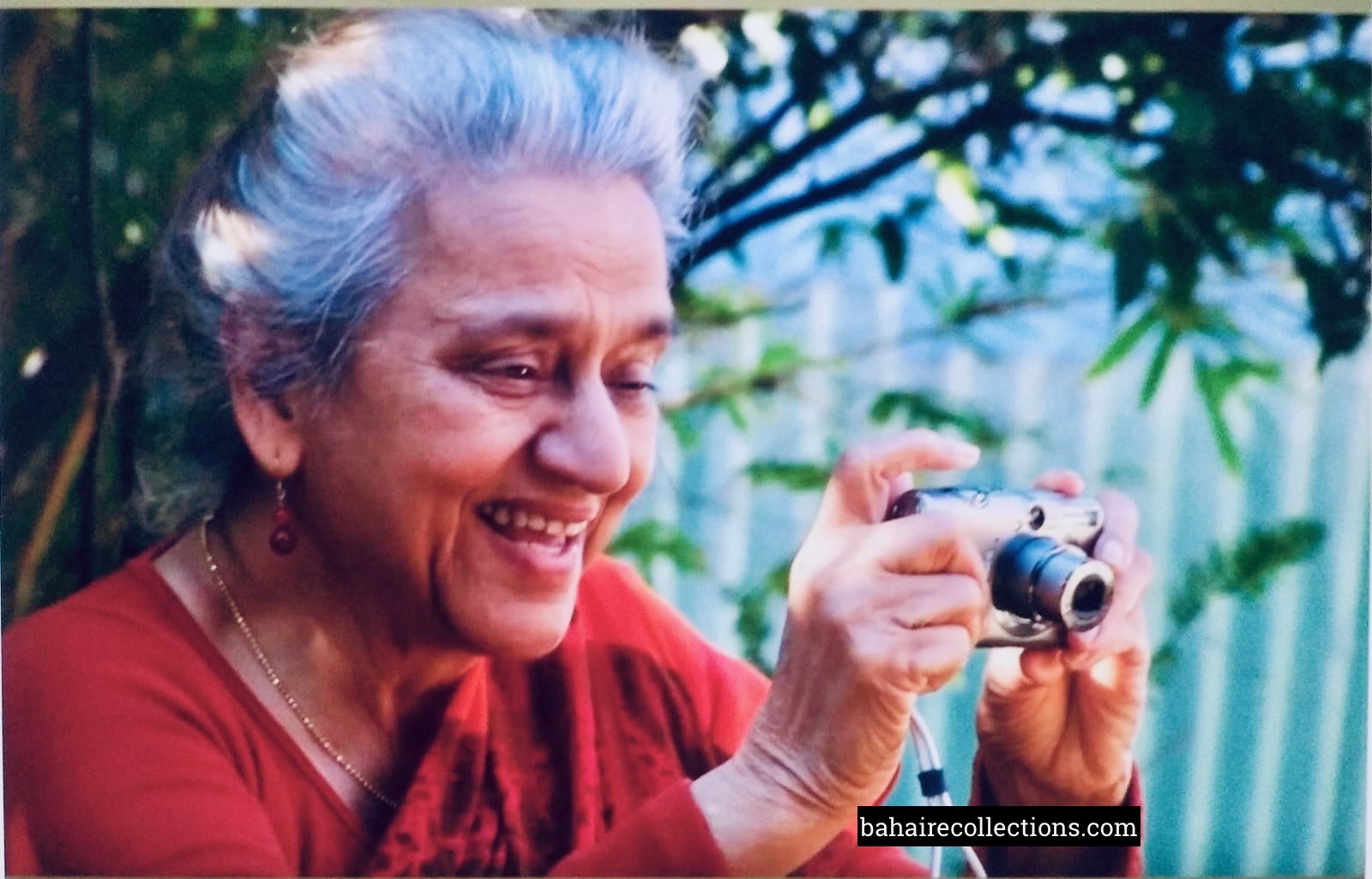
Photography – a teenage hobby that remained with her throughout.
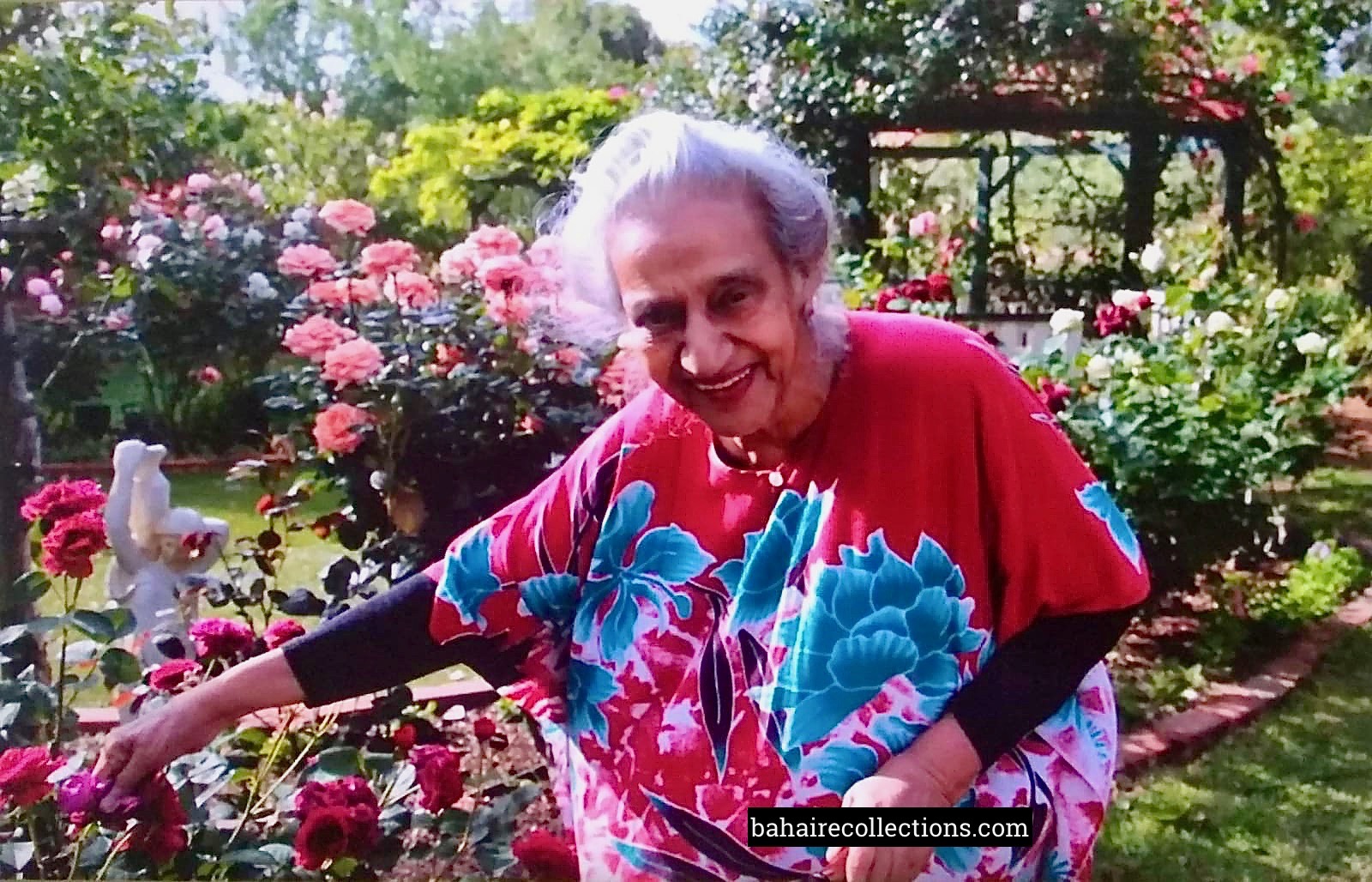
Hers was a colorful life – herself a Rose among roses.

A beautiful resting place at Freemantle Cemetery, Palmyra.
In its message to the National Spiritual Assembly of the Bahá‘ís of Australia dated 9 February 2017, the Supreme Body stated:
We were grieved to learn of the passing of Shantha Sundram, consecrated handmaiden of the Blessed Beauty. Her long years of tireless, sacrificial, and devoted labour to promote the Cause of God—as a member of the Continental Board of Counsellors in Asia, an Auxiliary Board member, and a member of the Spiritual Assembly of Malaysia—are recalled with deep admiration. May her shining example of a life dedicated to the service of the Faith be a source of inspiration for generations to come. We ardently supplicate at the Sacred Threshold for the progress of her radiant soul throughout the heavenly realms, and we extend our heartfelt sympathy to her daughters, Nita, Padma, Susheel, and Malini, and all other members of her family.
We call on your National Assembly and the Spiritual Assembly of Malaysia to hold memorial gatherings in her honour, and we ask that the National Assembly of India arrange a memorial service in the Bahá’í House of Worship in New Delhi.
Dr. Firaydun Mithaq
Chieng Mai
Thailand
31 March 2020
Copyright@bahairecollections.com
P.S: My gratitude to Mr. Manisegaran for providing additional information, and for uploading photographs and a video clipping of Shantha.
To get a fuller picture of Shantha, the author recommends the readers to read this other story on her husband Dr. Chellie Sundram: